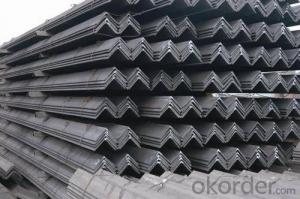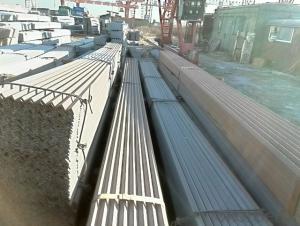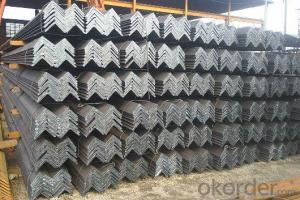Hot Rolled Steel Angles with High Quality
- Loading Port:
- Tianjin
- Payment Terms:
- TT OR LC
- Min Order Qty:
- 25 m.t.
- Supply Capability:
- 20000 m.t./month
OKorder Service Pledge
OKorder Financial Service
You Might Also Like
Product Description:
OKorder is offering high quality Steel Angle Bar at great prices with worldwide shipping. Our supplier is a world-class manufacturer of steel, with our products utilized the world over. OKorder annually supplies products to European, North American and Asian markets. We provide quotations within 24 hours of receiving an inquiry and guarantee competitive prices.
Product Applications:
Steel Angle Bars are ideal for structural applications and are widely used in the construction of buildings and bridges, and the manufacturing, petrochemical, and transportation industries.
Product Advantages:
OKorder's Steel Angle bars are durable, strong, and resist corrosion.
Main Product Features:
· Premium quality
· Prompt delivery & seaworthy packing (30 days after receiving deposit)
· Corrosion resistance
· Can be recycled and reused
· Mill test certification
· Professional Service
· Competitive pricing
Product Specifications:
Manufacture: Hot rolled
Grade: Q195 – 235
Certificates: ISO, SGS, BV, CIQ
Length: 6m – 12m, as per customer request
Packaging: Export packing, nude packing, bundled
Sizes: 25mm-250mm | ||
a*t | ||
25*2.5-4.0 | 70*6.0-9.0 | 130*9.0-15 |
30*2.5-6.6 | 75*6.0-9.0 | 140*10-14 |
36*3.0-5.0 | 80*5.0-10 | 150*10-20 |
38*2.3-6.0 | 90*7.0-10 | 160*10-16 |
40*3.0-5.0 | 100*6.0-12 | 175*12-15 |
45*4.0-6.0 | 110*8.0-10 | 180*12-18 |
50*4.0-6.0 | 120*6.0-15 | 200*14-25 |
60*4.0-8.0 | 125*8.0-14 | 250*25 |
FAQ:
Q1: Why buy Materials & Equipment from OKorder.com?
A1: All products offered byOKorder.com are carefully selected from China's most reliable manufacturing enterprises. Through its ISO certifications, OKorder.com adheres to the highest standards and a commitment to supply chain safety and customer satisfaction.
Q2: What makes stainless steel stainless?
A2: Stainless steel must contain at least 10.5 % chromium. It is this element that reacts with the oxygen in the air to form a complex chrome-oxide surface layer that is invisible but strong enough to prevent further oxygen from "staining" (rusting) the surface. Higher levels of chromium and the addition of other alloying elements such as nickel and molybdenum enhance this surface layer and improve the corrosion resistance of the stainless material.
Q3: Can stainless steel rust?
A3: Stainless does not "rust" as you think of regular steel rusting with a red oxide on the surface that flakes off. If you see red rust it is probably due to some iron particles that have contaminated the surface of the stainless steel and it is these iron particles that are rusting. Look at the source of the rusting and see if you can remove it from the surface.
Images:
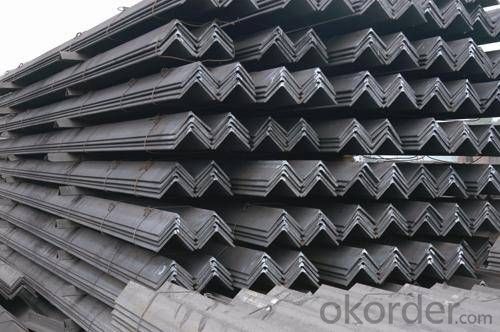
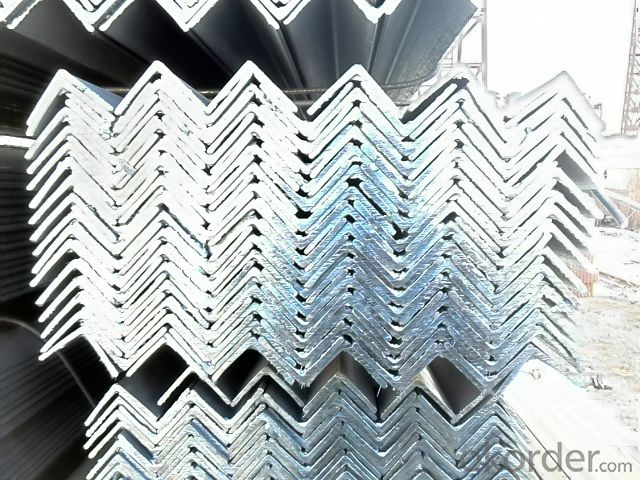

- Q:What are the common sizes of steel angles?
- Common sizes of steel angles vary depending on the specific application and industry. However, some standard sizes for steel angles include 1/2 inch, 3/4 inch, 1 inch, 1 1/2 inch, and 2 inches. These sizes are commonly used in construction, engineering, and manufacturing projects.
- Q:What are the different standards for steel angles?
- There are several different standards for steel angles, which are commonly used in construction and industrial applications. One of the most widely recognized standards is the American Society for Testing and Materials (ASTM) standard. ASTM A36 is a common grade for steel angles and specifies the chemical composition, mechanical properties, and tolerances for these structural shapes. It is commonly used for general structural purposes and is available in various sizes and lengths. Another prominent standard is the European standard, known as EN 10025. This standard includes several grades of steel angles, such as S235, S275, and S355, which correspond to different yield strengths. EN 10025 steel angles are widely used in construction, machinery, and engineering industries across Europe. In addition to these standards, there are also country-specific standards, such as the Japanese Industrial Standards (JIS) and the British Standards (BS). JIS G3101 is a well-known standard in Japan, which specifies the hot-rolled steel angles for general structures. BS EN 10056 is a British standard that provides specifications for steel angles used in construction. Furthermore, there are specialized standards for specific applications, such as marine-grade steel angles that are resistant to corrosion in saltwater environments. These standards, like ASTM A588, provide additional requirements for chemical composition and mechanical properties to ensure the steel angles' durability in harsh conditions. Overall, the different standards for steel angles ensure that these structural shapes meet specific requirements for strength, durability, and compatibility with various construction and industrial applications. It is crucial to refer to the appropriate standard when selecting steel angles to ensure they meet the necessary specifications for the intended use.
- Q:What are the different types of connections used with steel angles?
- There are several types of connections commonly used with steel angles, including bolted connections, welded connections, and clip connections. Bolted connections involve using bolts and nuts to fasten the angles together, while welded connections involve fusing the angles together using heat. Clip connections, on the other hand, involve using clips or brackets to connect the steel angles. Each type of connection has its own advantages and is used depending on the specific requirements and design considerations of the steel structure.
- Q:What are the standard dimensions of steel angles?
- The standard dimensions of steel angles vary depending on the specific type and grade of steel used. However, common standard dimensions for steel angles include leg lengths ranging from 1/2 inch to 8 inches and thicknesses ranging from 1/8 inch to 1 inch.
- Q:Are steel angles resistant to fire?
- Steel angles are generally considered to be fire resistant. Steel is a non-combustible material, meaning it does not burn or contribute to the spread of fire. However, it is important to note that while steel itself is resistant to fire, it can lose its strength when exposed to high temperatures for an extended period of time. In a fire situation, the temperature can rise rapidly, causing the steel to weaken and potentially compromise the structural integrity of a building or component. To enhance fire resistance, steel angles can be protected by applying fire-resistant coatings, such as intumescent paint or fireproofing materials. These coatings can provide additional insulation, delaying the steel's exposure to high temperatures and preventing its failure. Ultimately, the fire resistance of steel angles depends on various factors, including the duration and intensity of the fire, as well as the measures taken to enhance their fire performance. It is essential to consult with fire protection experts and adhere to building codes and regulations to ensure the appropriate level of fire resistance for steel angles in a specific application.
- Q:What is the cost of steel angles compared to other materials?
- The price of steel angles compared to other materials can differ based on various factors such as the grade and type of steel, market conditions, and availability. Nevertheless, in general, steel angles are typically a cost-effective choice when compared to other materials commonly utilized for structural or construction purposes. Steel angles find extensive use in numerous industries, including construction, manufacturing, and infrastructure, owing to their durability, strength, and versatility. When compared to materials like aluminum or stainless steel, steel angles are often more economical. This is due to the wide availability of steel as a material and its ability to be manufactured in large quantities, resulting in cost efficiencies in the production process. Moreover, steel angles have a lengthy lifespan and necessitate minimal upkeep, further enhancing their cost-effectiveness over time. They also possess exceptional load-bearing capabilities, making them suitable for a broad range of applications, including building frames, support structures, and machinery. However, it is crucial to note that the cost of steel angles can still fluctuate depending on the specific requirements and specifications of a project. Factors such as size, length, thickness, and any additional treatments or finishes can impact the price. Therefore, it is advisable to consult with suppliers or manufacturers to obtain accurate and up-to-date pricing information based on the individual needs of the project.
- Q:How do steel angles compare to other structural shapes?
- Steel angles are a versatile and commonly used structural shape in construction and engineering, offering several advantages over beams or channels. To begin with, their L-shaped design provides excellent strength and stability, making them ideal for load-bearing applications. They can effectively resist both compressive and tensile forces, making them suitable for a wide range of structural uses. Furthermore, steel angles have a compact and space-saving profile, making them more efficient in terms of material usage compared to beams or channels. This can result in cost savings and reduced weight in construction projects. Moreover, steel angles can be easily customized to fit specific project requirements. They can be cut, welded, drilled, and modified without compromising their structural integrity, allowing for easy integration into various structural systems. Additionally, steel angles offer versatile connection options. They can be bolted, welded, or riveted, providing flexibility in joining them with other structural components, making them suitable for a wide range of building and construction projects. Lastly, steel angles are readily available and cost-effective. They are widely produced and stocked by steel manufacturers, making them easily accessible. Their affordability, combined with their durability and strength, makes them a popular choice for structural applications. In summary, steel angles excel in strength, space-saving design, adaptability, connection options, and cost-effectiveness compared to other structural shapes. Their versatility and performance make them a preferred choice in various construction and engineering projects.
- Q:Are steel angles corrosion resistant?
- Steel angles, unless specially designed and treated, are generally prone to corrosion. They are typically made from carbon steel, which can corrode when exposed to moisture, oxygen, and other corrosive substances. Nevertheless, stainless steel angles, enhanced with chromium and other alloying elements, offer greater resistance to corrosion. These stainless steel angles are commonly employed in corrosive environments like marine or industrial settings. To evaluate the corrosion resistance of a steel angle, one must carefully consider its specific type and grade.
- Q:How many kilograms per square meter is angle steel 63*63*6?
- The dimension of angle iron is expressed by the dimension of the length of side and the thickness of edge. At present, the domestic steel specifications for 2 - 20 cm, to length number number, the same horn steel often have 2 - 7 different edge thickness. Imported steel angles indicate the actual sizes and edges of both sides and indicate the relevant standards. Generally, the length of 12.5cm is larger than that of angle steel, and between 12.5cm and 5cm is medium angle steel. The angle of 5cm is smaller than that of angle steel.
- Q:Can steel angles be used for manufacturing playground equipment?
- Yes, steel angles can be used for manufacturing playground equipment. Steel angles provide strength and stability, making them suitable for constructing various playground structures such as slides, swings, and climbing frames.
1. Manufacturer Overview |
|
|---|---|
| Location | |
| Year Established | |
| Annual Output Value | |
| Main Markets | |
| Company Certifications | |
2. Manufacturer Certificates |
|
|---|---|
| a) Certification Name | |
| Range | |
| Reference | |
| Validity Period | |
3. Manufacturer Capability |
|
|---|---|
| a)Trade Capacity | |
| Nearest Port | |
| Export Percentage | |
| No.of Employees in Trade Department | |
| Language Spoken: | |
| b)Factory Information | |
| Factory Size: | |
| No. of Production Lines | |
| Contract Manufacturing | |
| Product Price Range | |
Send your message to us
Hot Rolled Steel Angles with High Quality
- Loading Port:
- Tianjin
- Payment Terms:
- TT OR LC
- Min Order Qty:
- 25 m.t.
- Supply Capability:
- 20000 m.t./month
OKorder Service Pledge
OKorder Financial Service
Similar products
New products
Hot products
Related keywords
